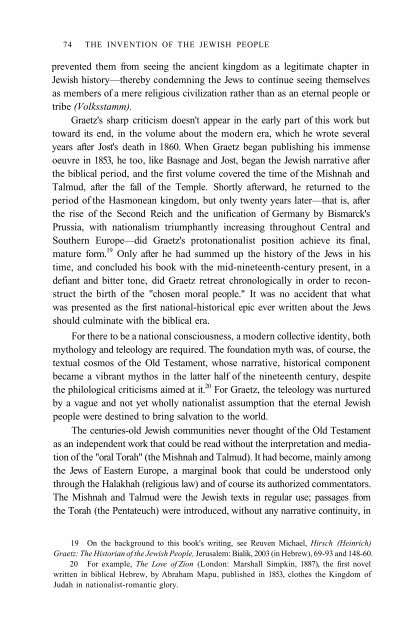Shlomo Sand, The Invention of the Jewish People - Rafapal
Shlomo Sand, The Invention of the Jewish People - Rafapal
Shlomo Sand, The Invention of the Jewish People - Rafapal
Create successful ePaper yourself
Turn your PDF publications into a flip-book with our unique Google optimized e-Paper software.
74 THE INVENTION OF THE JEWISH PEOPLE<br />
prevented <strong>the</strong>m from seeing <strong>the</strong> ancient kingdom as a legitimate chapter in<br />
<strong>Jewish</strong> history—<strong>the</strong>reby condemning <strong>the</strong> Jews to continue seeing <strong>the</strong>mselves<br />
as members <strong>of</strong> a mere religious civilization ra<strong>the</strong>r than as an eternal people or<br />
tribe (Volksstamm).<br />
Graetz's sharp criticism doesn't appear in <strong>the</strong> early part <strong>of</strong> this work but<br />
toward its end, in <strong>the</strong> volume about <strong>the</strong> modern era, which he wrote several<br />
years after Jost's death in 1860. When Graetz began publishing his immense<br />
oeuvre in 1853, he too, like Basnage and Jost, began <strong>the</strong> <strong>Jewish</strong> narrative after<br />
<strong>the</strong> biblical period, and <strong>the</strong> first volume covered <strong>the</strong> time <strong>of</strong> <strong>the</strong> Mishnah and<br />
Talmud, after <strong>the</strong> fall <strong>of</strong> <strong>the</strong> Temple. Shortly afterward, he returned to <strong>the</strong><br />
period <strong>of</strong> <strong>the</strong> Hasmonean kingdom, but only twenty years later—that is, after<br />
<strong>the</strong> rise <strong>of</strong> <strong>the</strong> Second Reich and <strong>the</strong> unification <strong>of</strong> Germany by Bismarck's<br />
Prussia, with nationalism triumphantly increasing throughout Central and<br />
Sou<strong>the</strong>rn Europe—did Graetz's protonationalist position achieve its final,<br />
mature form. 19 Only after he had summed up <strong>the</strong> history <strong>of</strong> <strong>the</strong> Jews in his<br />
time, and concluded his book with <strong>the</strong> mid-nineteenth-century present, in a<br />
defiant and bitter tone, did Graetz retreat chronologically in order to reconstruct<br />
<strong>the</strong> birth <strong>of</strong> <strong>the</strong> "chosen moral people." It was no accident that what<br />
was presented as <strong>the</strong> first national-historical epic ever written about <strong>the</strong> Jews<br />
should culminate with <strong>the</strong> biblical era.<br />
For <strong>the</strong>re to be a national consciousness, a modern collective identity, both<br />
mythology and teleology are required. <strong>The</strong> foundation myth was, <strong>of</strong> course, <strong>the</strong><br />
textual cosmos <strong>of</strong> <strong>the</strong> Old Testament, whose narrative, historical component<br />
became a vibrant mythos in <strong>the</strong> latter half <strong>of</strong> <strong>the</strong> nineteenth century, despite<br />
<strong>the</strong> philological criticisms aimed at it. 20 For Graetz, <strong>the</strong> teleology was nurtured<br />
by a vague and not yet wholly nationalist assumption that <strong>the</strong> eternal <strong>Jewish</strong><br />
people were destined to bring salvation to <strong>the</strong> world.<br />
<strong>The</strong> centuries-old <strong>Jewish</strong> communities never thought <strong>of</strong> <strong>the</strong> Old Testament<br />
as an independent work that could be read without <strong>the</strong> interpretation and mediation<br />
<strong>of</strong> <strong>the</strong> "oral Torah" (<strong>the</strong> Mishnah and Talmud). It had become, mainly among<br />
<strong>the</strong> Jews <strong>of</strong> Eastern Europe, a marginal book that could be understood only<br />
through <strong>the</strong> Halakhah (religious law) and <strong>of</strong> course its authorized commentators.<br />
<strong>The</strong> Mishnah and Talmud were <strong>the</strong> <strong>Jewish</strong> texts in regular use; passages from<br />
<strong>the</strong> Torah (<strong>the</strong> Pentateuch) were introduced, without any narrative continuity, in<br />
19 On <strong>the</strong> background to this book's writing, see Reuven Michael, Hirsch (Heinrich)<br />
Graetz: <strong>The</strong> Historian <strong>of</strong> <strong>the</strong> <strong>Jewish</strong> <strong>People</strong>, Jerusalem: Bialik, 2003 (in Hebrew), 69-93 and 148-60.<br />
20 For example, <strong>The</strong> Love <strong>of</strong> Zion (London: Marshall Simpkin, 1887), <strong>the</strong> first novel<br />
written in biblical Hebrew, by Abraham Mapu, published in 1853, clo<strong>the</strong>s <strong>the</strong> Kingdom <strong>of</strong><br />
Judah in nationalist-romantic glory.




